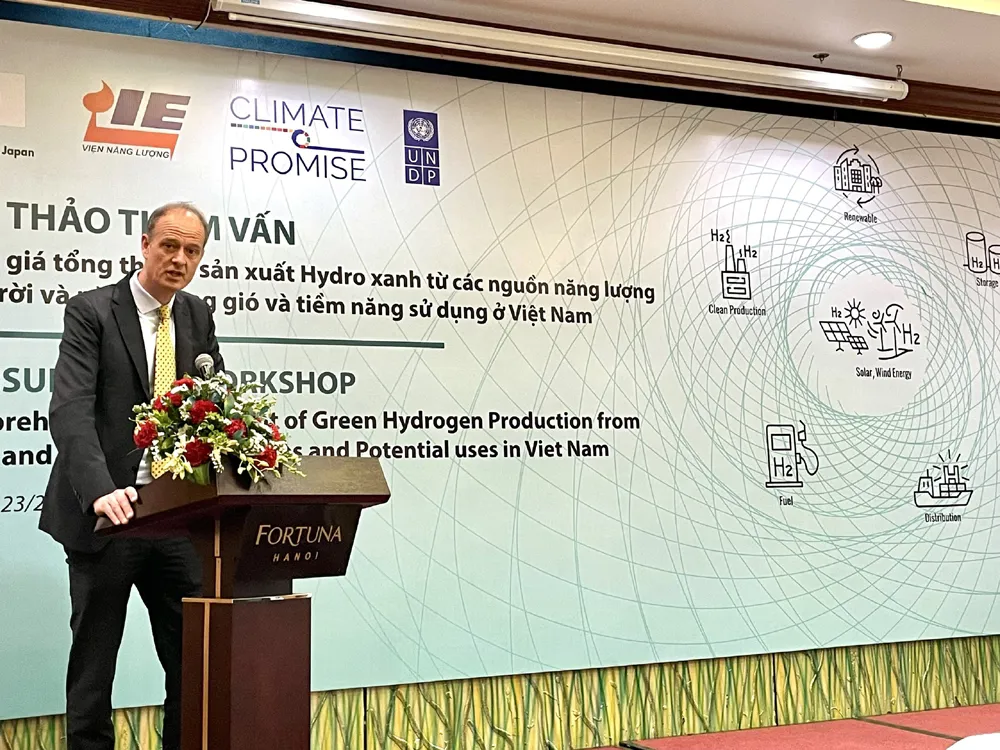Research is typical to green hydrogen production in Vietnam
Green hydrogen is a promising kind of energy in Vietnam amid the pressing threat of climate change and the need to reduce greenhouse gas emissions.
Research and development are crucial to green hydrogen production in Vietnam, which has emerged as a robust solution in the global pursuit of a greener future.
| Patrick Haverman, UNDP Deputy Resident Representative in Vietnam. Photo: UNDP Vietnam |
Patrick Haverman, UNDP Deputy Resident Representative in Vietnam, shared the view to address the potential for green hydrogen production, enabled by expanding renewable energy capacity and falling costs of solar and wind production.
Haverman said at the workshop on “Comprehensive Assessment of Green Hydrogen Production from Solar and Wind Power Sources and Potential Uses in Vietnam” with a focus on the South-Central Coast and Southwest regions.
“Research and development are crucial to determining the potential use cases, decarbonization potential, improving efficiency, and reducing the cost of green hydrogen production technologies,” he said.
Additionally, a clear policy and regulatory framework would be important to the development of green hydrogen, requiring concerted efforts by government, businesses, academia, and civil society to realize a transition from fossil fuel-derived feedstocks.
Finally, developing the necessary infrastructure to produce, store, and distribute green hydrogen safely in Vietnam will be crucial, he emphasized.
Vietnam is rapidly expanding its solar and wind energy capacity. However, it must also ensure that necessary electrolyzers are positioned at or near renewable energy facilities for any dedicated green hydrogen projects.
Sharing the same idea, Nguyen The Thang, Head of the Department of Environment and Sustainable Development, Institute of Energy, said: “With our nation's rapid economic growth and increasing renewable energy capacity, green hydrogen holds tremendous promise as a critical contributor to accelerating the clean energy transition.”
| Green hydrogen is considered future energy. File photo |
Potential
Vietnam, one of the world's fastest-growing economies and recognizing the pressing threat of climate change and the need to reduce emissions, has made remarkable strides in renewable energy deployment.
With a compound annual growth rate of 5.7% over this decade, the country has embarked on an ambitious path to sustainably meet its rising energy, sourcing approximately 47% of its power from renewable energy sources by 2050.
Green hydrogen holds immense promise for developing countries like Vietnam with high renewable energy potential and rapid growth in renewables. The applications of green hydrogen are vast, ranging from shipping and transportation to decarbonizing hard-to-abate industries such as steel and chemicals and blending it into existing natural gas networks for heating in buildings.
The International Partners Group, including G7, EU, Denmark and Norway, of Just Energy Transition Partnership (JETP) and Vietnam, have identified green hydrogen production as a key priority in JETP Political Declaration.
However, green hydrogen production and use is a new field for Vietnam. While the country has witnessed the preparation of several green hydrogen investment projects, there remains a need for a comprehensive regulatory framework and research, development on the technology for green hydrogen fuel development, and potential consumption across various industries.
The assessment report presented three scenarios for GH2 production from renewable energy (RE) sources. It assessed the potential production capacity and levelized cost of hydrogen (LCOH). It also featured economic and statistical analysis based on the latest data on domestic and renewable electricity projections, current and future green hydrogen and ammonia demand estimates, and discussions on the national policy and legislative framework necessary for developing green hydrogen.
The workshop was an important contribution to advancing the nation's clean energy goals.












